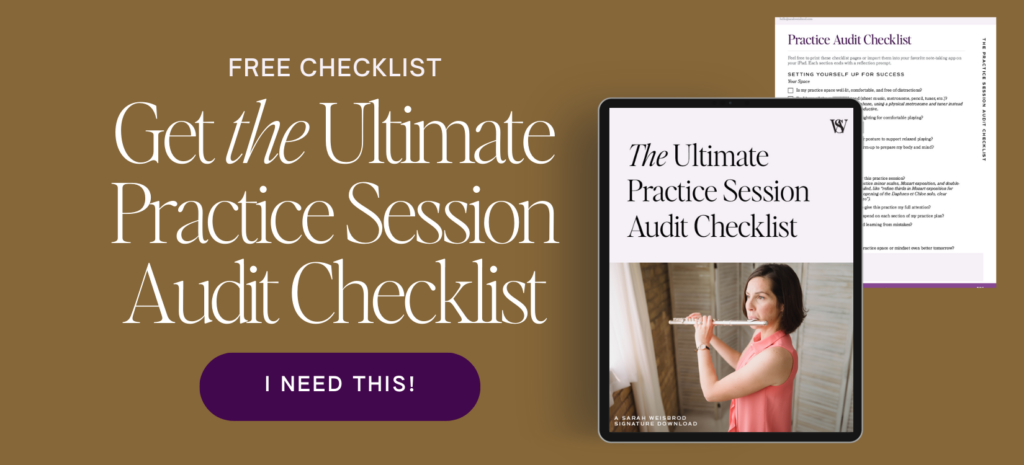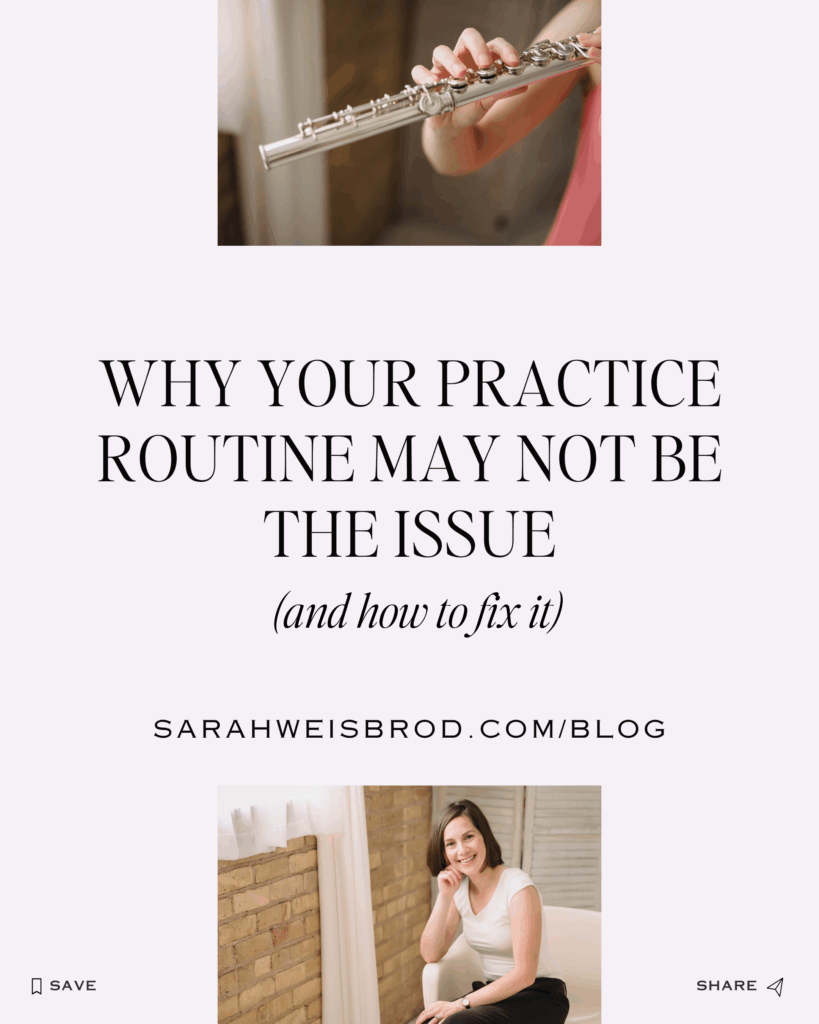“It sounded better in the practice room.”
Raise your hand if you’ve ever said that at a lesson.
I know I’ve said it to my teachers, and my students have also said the same thing to me.
If this sounds like you, you’re likely putting in a tremendous amount of hours practicing. But when it comes time to play that difficult passage you painstakingly woodshedded, it falls apart.
The problem isn’t your practice routine but the strategies and techniques you use during practice sessions that may be holding you back.
In other words, it’s not about practicing more—it’s about practicing smarter.
In this post, we’ll unpack what’s really going on when progress stalls and how to shift your approach so your hard work finally pays off on stage.
You’ll learn:
- Why your practice routine might not be the real issue
- The hidden habits that derail even seasoned musicians
- How to practice more effectively using strategy, mindset, and artistry
BTW, save time in your next practice session by grabbing your free practice audit checklist. Skip the self-doubt and make sure you never miss another beat.

Why More Practice Time Doesn’t Equal More Progress
Yes, you need to practice, but more hours don’t equal more results. It’s about how you practice that enables you to make significant improvements. If you are intentional with your practice time, you can get more done in less time.
When you push yourself to practice for hours on end, you eventually meet the law of diminishing returns. You know that feeling—where you tell yourself just one more run-through, and all of a sudden it feels like the last 3 hours have been a waste.
It’s better to end a practice session on a high note than push yourself too hard just because you feel like you should or because you have to meet some magical 3-hour mark. The most efficient musicians can make significant progress in as little as 30 minutes. That’s because they have the right practice strategies in place. (If you’re interested in learning more about how you can better optimize your time in the practice room, sign up for a practice strategy session.)
The Missing Strategy in Your Practice Routine
There are only 24 hours in a day. And if you go into a practice session and play whatever’s on your stand, you’re going to waste time and energy.
When it comes to being strategic with your practice time, you need to organize your practice sessions so you’re not spending too much time on one thing. I can’t tell you how many times I intended to work on something for just 15 minutes, only to find that 30 minutes had passed before I knew it.
It’s not only about being strategic with your practice time, but you also need effective practice techniques for isolating challenging passages. And you need to practice in a way that ensures mistakes that you fix in the practice room don’t find their way back in a performance.
One of the main ways we’re taught to fix mistakes is through repetition—by mindlessly repeating something until you get it right. But if you play the wrong notes more times than you play the right ones, you’ll end up playing the wrong notes in a performance. This is because when you get nervous and your body’s fight-or-flight response kicks in, it defaults to what it knows best. And if you’ve played that difficult passage incorrectly more times than correctly, you’ll end up playing the wrong notes.
Remember, practice makes permanent. How you practice is how you’ll perform.
One of my favorite practice techniques is utilizing both fast and slow practice. (I cover this extensively inside The Practice Code for Musicians.) Slow practice gives you time to accurately learn the notes, and fast practice helps you work on coordination to execute those notes at, or near, performance tempo.
The Mindset Shift Every Musician Needs
Your mind is more powerful than your technique. Your subconscious believes what you tell it. And if you’re constantly saying to yourself, “I hope I nail that passage,” or “don’t mess this up,” chances are, you’re going to mess up.
I remember rehearsing an incredibly delicate chord in orchestra. The principal flutist had a high E (which tends to run sharp), and I had a B above the staff. It runs flat at mezzo-forte, but this chord was marked piano, so I really had to work to keep the pitch up.
In one rehearsal, I told myself, “Don’t go flat.” And can you guess what happened? I went flat. But in the next rehearsal, I told myself that I know how to make the diminuendo, I just need to do XYZ. And I had so much control over my pitch.
In that correction, I did two important things that create a healthy mindset: I eliminated negative self-talk and self-doubt.
I always encourage my students to avoid the words “don’t” and “can’t.” When they shift their self-talk to the desired outcome—not what to avoid—they have better success.
Another way to improve your mindset is to use objective feedback instead of subjective feedback. Saying things like “I suck” or “I’ll never get this,” don’t provide concrete things to fix. Instead, ask yourself what went right or wrong. “These notes were uneven” is much more helpful than saying you will never be able to play a passage.
And finally, remember that no musician, no matter how good they are, is perfect. When you accept that mistakes happen, even to the best players, you’ll free yourself from the pressure of being perfect.
How to Practice Like an Artist, Not a Technician
It’s easy when we’re practicing to focus only on what we need to do technically. But if musicality is something that you only work on after you’ve figured out the notes, then you’re going to spend twice as much time on the same passage.
Instead, while you’re learning the notes, think about things like the tone color you want, what kind of vibrato you want to use, vowel shapes, and bow speed and pressure (for string players).
Find the skeleton in each phrase so you know which notes are important and why. Use the rhythm to help you find the character of each phrase, section, and the piece as a whole. Study the score to find out where there are unexpected harmonic moments you can bring out.
There’s a story to tell in every piece, and it’s up to you to tell it. All the clues lie in the score, so use it to your advantage.
At the end of the day, your practice routine isn’t broken—it just needs better direction.
You’ve seen how simply adding more time in the practice room doesn’t guarantee progress. What matters is how you use that time:
- Strategy gives your sessions structure and clarity so you know exactly what to focus on.
- Mindset helps you stay calm, curious, and confident when things don’t click right away.
- Artistry transforms your work from mechanical to meaningful—so your technique serves the music, not the other way around.
When these three elements work together, you start to practice more effectively, make measurable progress, and feel truly prepared for performance.
So before you add another hour to your schedule, take a closer look at what’s really happening inside your practice sessions.
If you’re ready to level up your practice sessions, check out this post on 11 essential steps to take your playing to the next level.
And if you found this post helpful, let me know your favorite takeaway in the comments below.
⬇️⬇️⬇️ Don’t forget to grab your copy of the Practice Audit Checklist so you never miss a beat in your next practice session. ⬇️⬇️⬇️


+ show Comments
- Hide Comments
add a comment